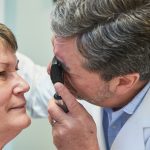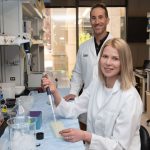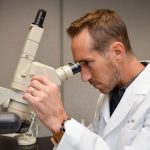Scott M. Plafker, Ph.D., R.Ph.
Professor
Aging & Metabolism Research Program
My 101
The guiding principle of our research program is that diet and nutrition are the foundation of health and healthy aging. This means that food choices not only play a critical role in preventing and treating diseases but can also be an underlying cause of some ailments. We are particularly interested in understanding how diet contributes to diseases of the eye and how nutrition can be leveraged to prevent and treat vision loss. Our research focuses on two diseases that cause blindness: (1) age-related macular degeneration (AMD) and (2) the optic neuritis associated with multiple sclerosis (MS). Both of these diseases can culminate in irreversible blindness and dramatically reduce the quality of life for patients.
We have two major projects in the lab currently. One aims to identify the beneficial effects of sulforaphane, a compound found in green, leafy vegetables like broccoli, Brussels sprouts and kale. Our studies are focused on determining the impact of sulforaphane on rejuvenating mitochondria, the energy producing organelles in our cells that decrease in function with aging and are widely believed to play a causal role in AMD onset and progression. A second project focuses on comparing the impact of high versus low carbohydrate diets on the motor and visual symptoms of MS. This work is being done using a mouse model that mimics many of the cardinal symptoms experienced by MS patients.
It is our ultimate goal to empower patients with dietary information and practices that they can apply each day to improve and maintain their overall health and vision.
Research
Our research program can be summarized by the adage, “Food as medicine.” We believe that food and nutrition reside at the center of health and healthy aging. Of course, there are two sides to every coin, and our food choices can promote health or disease. Therefore, we seek to explain at the biochemical, cell biological, and metabolic levels how certain food-derived compounds and diets promote health whereas others drive disease.
In this context, our laboratory focuses on how cells adapt to stresses and how nutrition impacts these responses. A central theme guiding our work is that healthy aging requires cells to retain the capacity to sense stresses, and then respond and adapt in a measured way to restore homeostasis. Examples of the stresses we study include oxidative stress, starvation, and hyperglycemia. The failure to appropriately deal with such stresses results in maladaptive responses that manifest as inflammation, tissue damage, and senescence. We are particularly interested in understanding how the transcription factors Nrf2, HIF-1a, and p53 function in a coordinated fashion to neutralize stresses, restore homeostasis, and prevent senescence. Loss or gain of function of these anti-stress transcription factors is linked to diseases ranging from cancers to age-related neurodegeneration to autoimmune disorders.
A main project in the laboratory involves testing how diets with either high or low amounts of carbohydrates impact the motor and vision deficits observed in multiple sclerosis (MS). We are using a mouse model of MS that reconstitutes many of the pathologies experienced by patients and our ultimate goal is to develop nutritional intervention strategies for MS patients. At the mechanistic level, we are exploring how anti-stress transcription factors respond to excess dietary carbohydrates and how various populations of T effector cells expand or contract as a function of diet. We anticipate that carbohydrate restriction will mitigate disease symptoms by reducing pathological T cells and expanding immune tolerant T regulatory cells.
A second project in our laboratory investigates the therapeutic potential and limitations of sulforaphane, a natural compound derived from cruciferous vegetables (e.g., broccoli, Brussels sprouts, kale). Sulforaphane is a potent activator of the Nrf2 transcription factor and is currently being tested in clinical trials for many diseases. In 2017, we discovered that sulforaphane can alter mitochondrial and peroxisomal morphology. Our current focus is to determine the consequences of these morphological changes on organelle function and cellular homeostasis. We are also testing whether sulforaphane can preserve vision in mouse models designed to mimic features of age-related macular degeneration (AMD), a leading cause of irreversible vision loss in people over the age of 65. AMD is typically characterized by death of the light-sensing photoreceptors in the posterior eye, and we are examining which protective properties of sulforaphane require Nrf2 and whether diets enriched in sulforaphane can preserve vision in young and old mice.
Brief CV
Education
B.S., Rutgers University College of Pharmacy, Piscataway, NJ, 1992
Ph.D., Johns Hopkins University, School of Medicine, Baltimore, MD, 1998
Postdoc, University of Virginia, Center for Cell Signaling, Charlottesville, VA, 1998-2003
Honors & Awards
Rutgers University, College of Pharmacy Student Research Award, 1992
Rutgers University, College of Pharmacy Analytical Chemistry Award, 1992
Postdoctoral Individual National Research Service Award – National Institutes of Health, 2000-2001
American Cancer Society Postdoctoral Fellowship, 2002-2003
Oklahoma Center for the Advancement of Science and Technology New Scientist Award, 2004
Travel Fellowship, XIII International Symposium on Retinal Degenerations, Emeishan, China, 2008
Travel Fellowship, XVIII International Congress of Eye Research, Beijing, China, 2008
Young Investigator Travel Award, American Diabetes Association 69th Annual Meeting, New Orleans, LA, 2009
J. Donald and Patricia Capra Award for Scientific Achievement, 2018
Memberships
American Association for the Advancement of Science
American Society of Cell Biology
Association for Research in Vision and Ophthamology
International Congress of Eye Research
Joined OMRF scientific staff in 2011
Publications
Recent Publications
Plafker KS, Georgescu C, Pezant N, Pranay A, Plafker SM. Sulforaphane acutely activates multiple starvation response pathways. Front Nutr 11:1485466, 2025 January, PMID: 39867556, PMCID: PMC11758633
Chucair-Elliott AJ, Ocañas SR, Pham K, Machalinski A, Plafker S, Stout MB, Elliott MH, Freeman WM. Age- and sex- divergent translatomic responses of the mouse retinal pigmented epithelium. Neurobiol Aging 140:41-59, 2024 May, PMID: 38723422, PMCID: PMC11173338
Titcomb TJ, Giesser BS, Plafker SM, Katz Sand IB, Wahls TL. Editorial: Diet and multiple sclerosis. Front Neurol 14:1347478, 2023 December, PMID: 38152642, PMCID: PMC10751951
Selected Publications
Zyla K, Larabee CM, Georgescu C, Berkley C, Reyna T, Plafker SM. Dimethyl fumarate mitigates optic neuritis. Mol Vis. 2019 Aug 22;25:446-461. eCollection 2019. PMID: 31523122, PMCID: PMC6707756
Borcherding DC, Siefert ME, Lin S, Brewington J, Sadek H, Clancy JP, Plafker SM, Ziady AG. Clinically-approved CFTR modulators rescue Nrf2 dysfunction in cystic fibrosis airway epithelia. J Clin Invest. 2019 May 30;129(8):3448-3463. doi: 10.1172/JCI96273. PMID: 31145101, PMCID: PMC6668689
Plafker KS, Zyla K, Berry W, Plafker SM. Loss of the ubiquitin conjugating enzyme UBE2E3 induces cellular senescence. Redox Biol. 2018 Jul;17:411-422. doi: 10.1016/j.redox.2018.05.008. Epub 2018 May 21. PMID: 29879550, PMCID: PMC6007080
Chen M, Nowak DG, Narula N, Robinson B, Watrud K, Ambrico A, Herzka TM, Zeeman ME, Minderer M, Zheng W, Ebbesen SH, Plafker KS, Stahlhut C, Wang VM, Wills L, Nasar A, Castillo-Martin M, Cordon-Cardo C, Wilkinson JE, Powers S, Sordella R, Altorki NK, Mittal V, Stiles BM, Plafker SM, Trotman LC. The nuclear transport receptor Importin-11 is a tumor suppressor that maintains PTEN protein. J Cell Biol. 2017 Mar 6;216(3):641-656. doi: 10.1083/jcb.201604025. Epub 2017 Feb 13. PMID: 28193700, PMCID: PMC5350510
O'Mealey GB, Berry WL, Plafker SM. Sulforaphane is a Nrf2-independent inhibitor of mitochondrial fission. Redox Biol. 2017 Apr;11:103-110. doi: 10.1016/j.redox.2016.11.007. Epub 2016 Nov 21. PMID: 27889639, PMCID: PMC5126150
Larabee CM, Desai S, Agasing A, Georgescu C, Wren JD, Axtell RC, Plafker SM. Loss of Nrf2 exacerbates the visual deficits and optic neuritis elicited by experimental autoimmune encephalomyelitis. Mol Vis. 2016 Dec 30;22:1503-1513. eCollection 2016. PMID: 28050123, PMCID: PMC5204460
Contact
Aging & Metabolism Research Program, MS 46
Oklahoma Medical Research Foundation
825 N.E. 13th Street
Oklahoma City, OK 73104
Phone: (405) 271-1735, (405) 271-1745
Fax: (405) 271-1437
E-mail: Scott-Plafker@omrf.org
For media inquiries, please contact OMRF’s Office of Public Affairs at news@omrf.org.
Lab Staff
Dorothy Walton
Research Technician II
Holly Smith
Administrative Assistant III
News from the Plafker lab

May Dr. Scott Plafker likes medical solutions that don’t come in pill bottles. In his OMRF lab, he’s studied how a compound naturally produced in broccoli, cabbage, cauliflower and Brussels sprouts can protect eyes as they age. “Because it’s readily available in vegetables, people can get it with ease, and they can get it without […]

December The Nonagenarian Society gets – and gives – a lesson in healthy aging. The questions flew fast and furious. How do OMRF scientists share their findings with physicians? What level of detail do researchers include in their grant proposals to funding agencies? How many individual patient samples were used for a particular research project on chemotherapy […]

Illustration: Doug Chayka We all know regular servings of food from our gardens are important for good health. Now, a new research project at OMRF aims to show how a chemical found in a host of vegetables could help prevent vision loss. With a four-year grant from the National Eye Institute, Dr. Scott Plafker […]





















